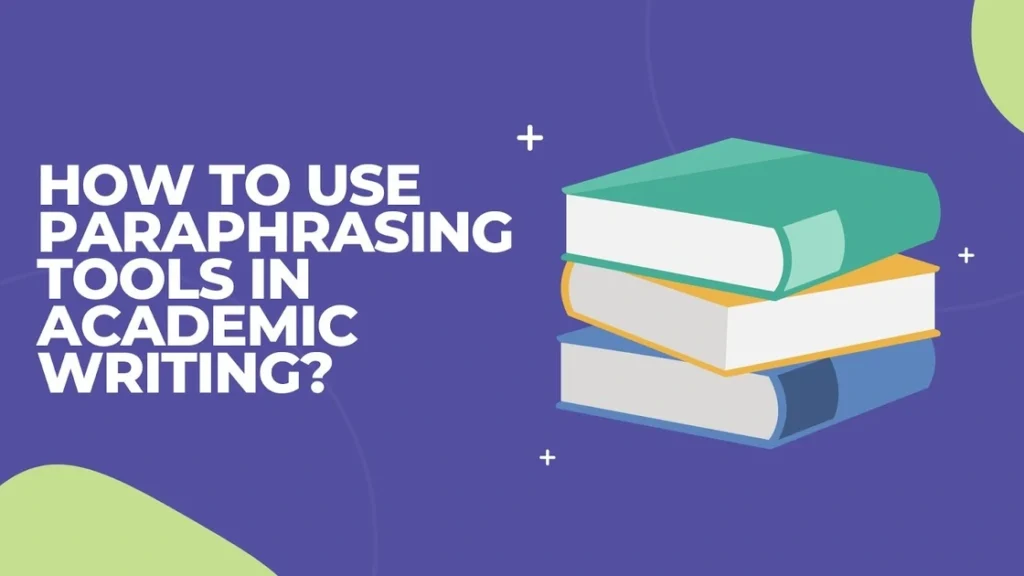Academic writing can feel intense.
You’re constantly researching, trying to communicate big ideas clearly, & following the rules of citing sources.
For many students, it’s a struggle to find the right words & avoid accidental plagiarism.
Paraphrasing tools have become a popular aid in this process.
How?
They allow students to paraphrase ideas in a fresh way without losing their original meaning. But using these tools effectively takes a little know-how, & that’s what this article is here to help you with.
Let’s look at how paraphrasing tools can fit into your academic writing & help you make sure your work is both original & respectful of the sources you’re building on.

1. Know When to Paraphrase
You’re probably familiar with quoting directly from a source.
However, paraphrasing can be an even better option in academic writing. If you find a piece of information that’s important but doesn’t need to be quoted word-for-word, paraphrasing can make it sound more natural in your voice.
Paraphrasing also shows that you’ve understood the source well enough to rewrite it, which is something educators look for. But here’s the key: not every sentence needs to be paraphrased.
With that in mind, you need to paraphrase when it actually adds value to your paper.
2. Pick the Right Tool
Not all paraphrasing tools are the same.
Some may provide a simple rewording that feels choppy. Others use AI to match your style better.
Spend a few minutes testing out a few tools until you find one that does the job well.
Choose a free paraphrasing tool that offers several modes so you can receive the output in your desired tone & style.
Additionally, look for tools that understand context so they don’t twist your text into confusing sentences.
Many paraphrasers offer added features like grammar checks. This can be a bonus if you want your paraphrased content to sound polished & professional.
Whichever tool you choose, make sure it doesn’t over-complicate sentences.
3. Don’t Rely on Tools Alone
Even the best paraphrasing tool won’t get everything right. They’re just the tools. After running a sentence through the tool, take time to double-check that the meaning is accurate.
It’s easy for nuances to get lost in translation, especially in academic topics where precision matters.
Use the paraphraser as a starting point & let your own understanding of the topic be your guide. Don’t simply copy-paste the tool’s output into your paper without making sure it’s truly in line with what you want to say.
4. Add Your Voice
One of the most valuable skills in academic writing is sounding like you.
Your professors & classmates can tell when your words suddenly switch to something that sounds too “techy” or unnatural. After you paraphrase a passage, add a touch of your style to make sure it flows well with the rest of your paper.
For instance, if a sentence comes out overly formal, simplify it.
In academic writing, clarity is king.
When you’re paraphrasing, make sure that every sentence still sounds like you.
5. Cite the Original Source
Paraphrasing doesn’t mean the idea becomes yours.
Even if you’ve changed the words, the idea belongs to the original author, & giving credit is essential. The best way to avoid plagiarism is to cite your source.
Many students make the mistake of thinking paraphrasing removes the need for citations.
It doesn’t.
Always check the citation style your institution requires, such as APA, MLA, or Chicago, & follow it to the letter.
6. Avoid Changing the Meaning
A good AI paraphraser tool maintains the original meaning, so you don’t need to panic about the context.
However, it’s recommended to double-check the results.
You want to retain the original intent.
If the tool’s suggestion doesn’t match the original meaning, paraphrase it yourself. This way, you stay true to the source & avoid spreading incorrect information.
7. Keep Your Writing Concise
Long, complicated sentences can make your writing harder to read.
Most paraphrasing tools aim for simpler language, but they can still create lengthy phrases if they’re not fine-tuned.
As you review your paraphrased content, see if you can simplify it further.
Shorter, clearer sentences are easier to follow & more effective in getting your point across.
Aim to keep your writing concise & to the point.
8. Use Paraphrasing Tools for Learning, Not Just Writing
An AI paraphraser gives a great helping hand to students write assignments.
But you should use it as a learning tool. You can see how a sentence might be reworded in different ways, which can improve your writing skills over time.
Try using a paraphrasing tool to help you learn new ways to say things & expand your vocabulary. The more you practice paraphrasing in your own words, the more confident you’ll be in your writing.
9. Experiment with Different Phrasing
One benefit of using a paraphrasing tool is that it gives you different options for rephrasing. For example, some tools have modes that allow you to choose a more formal or fluent tone.
Try running a sentence through a couple of different tools to see which version sounds best for your assignment. This way, you’re not locked into one version of your sentence.
It’s all about finding what fits your writing style & the tone of your assignment best.
10. Proofread Everything
Last but definitely not least, proofread.
A tool can paraphrase a sentence, but it won’t catch every typo or grammar issue. After using a paraphrasing tool, read through your work one more time to ensure accuracy & readability.
Make sure the sentences flow together naturally, without any robotic phrases. If a sentence seems too formal or doesn’t sound quite right, tweak it until it does.
Wrap-Up
Paraphrasing tools help students with academic writing. By understanding when & how to use them effectively, you can make sure your assignments are original, clear, & insightful.
Using these tools well takes a little practice, but with time, you’ll find they’re great allies in your academic journey. Give yourself room to try different methods, refine your work, & let your voice shine through.
